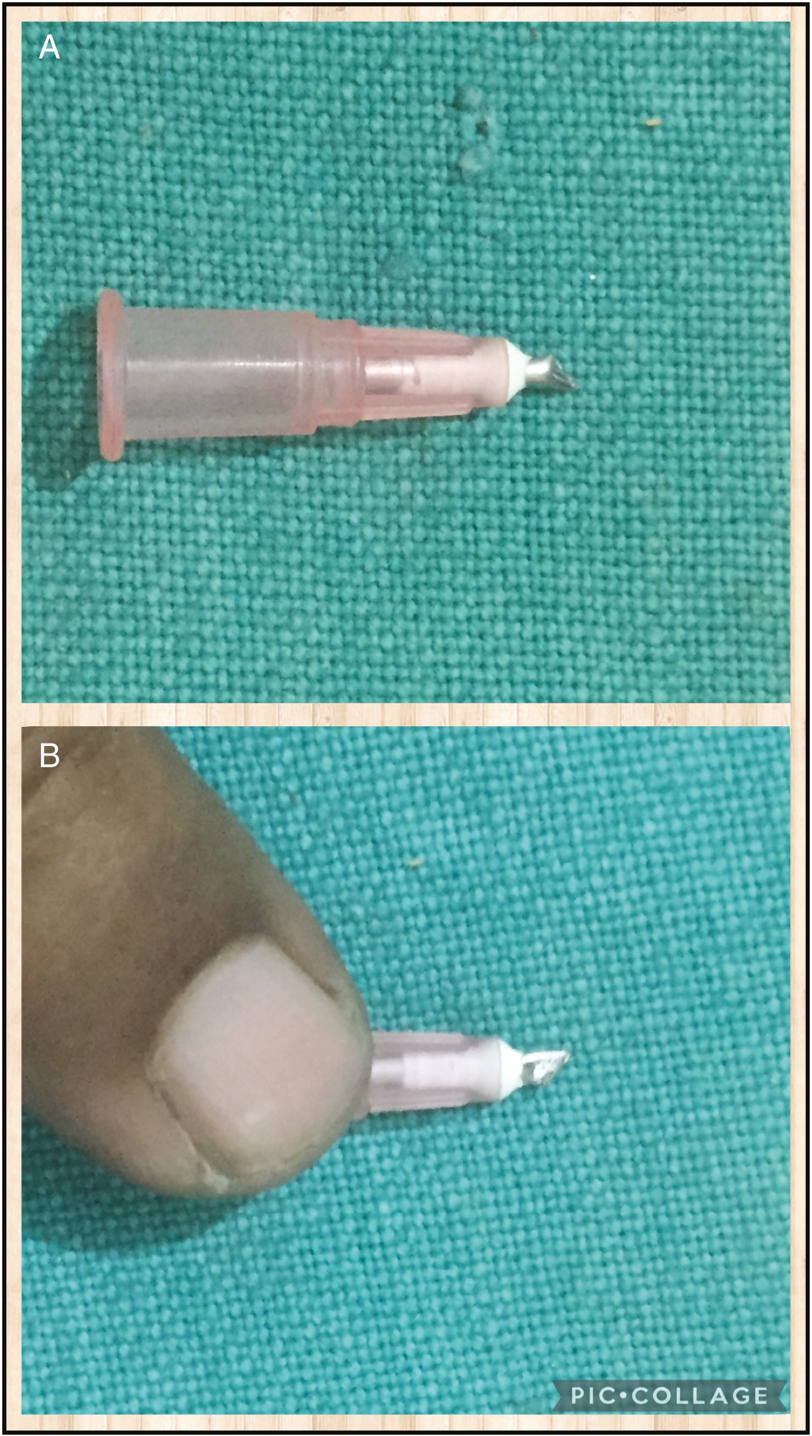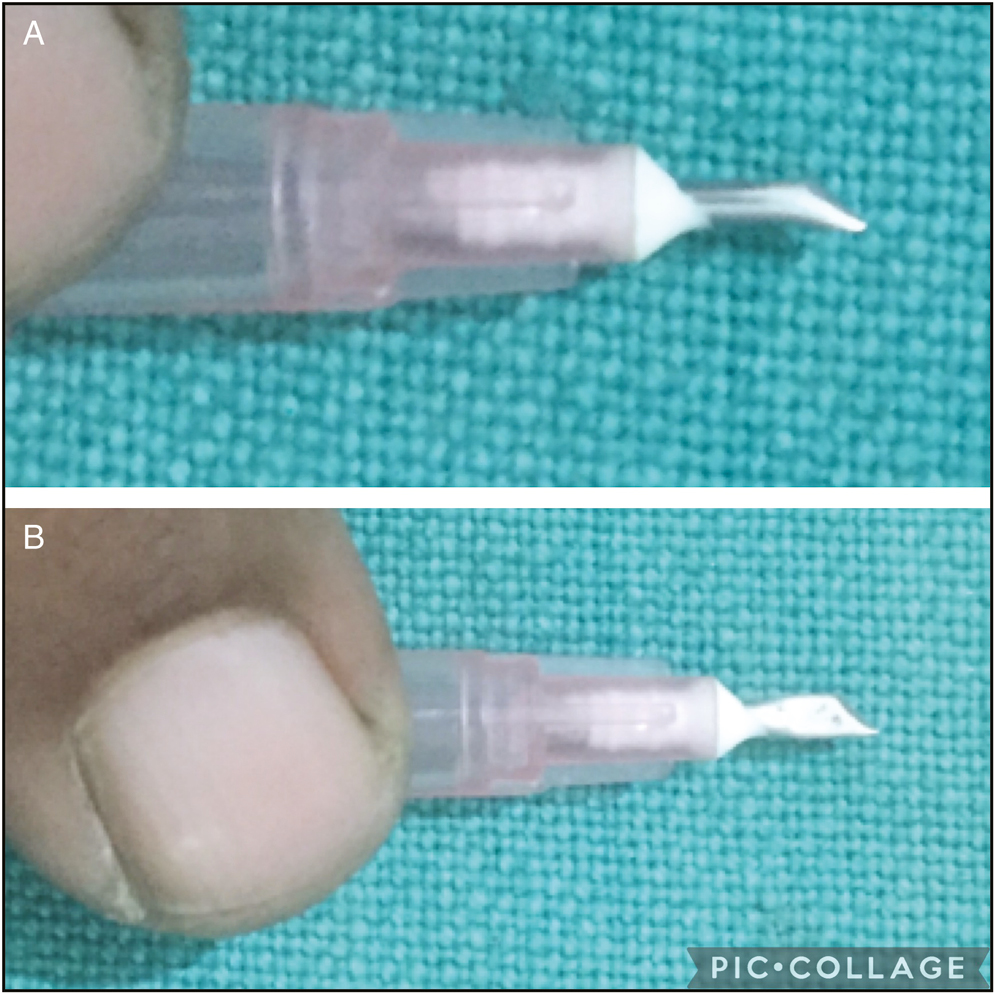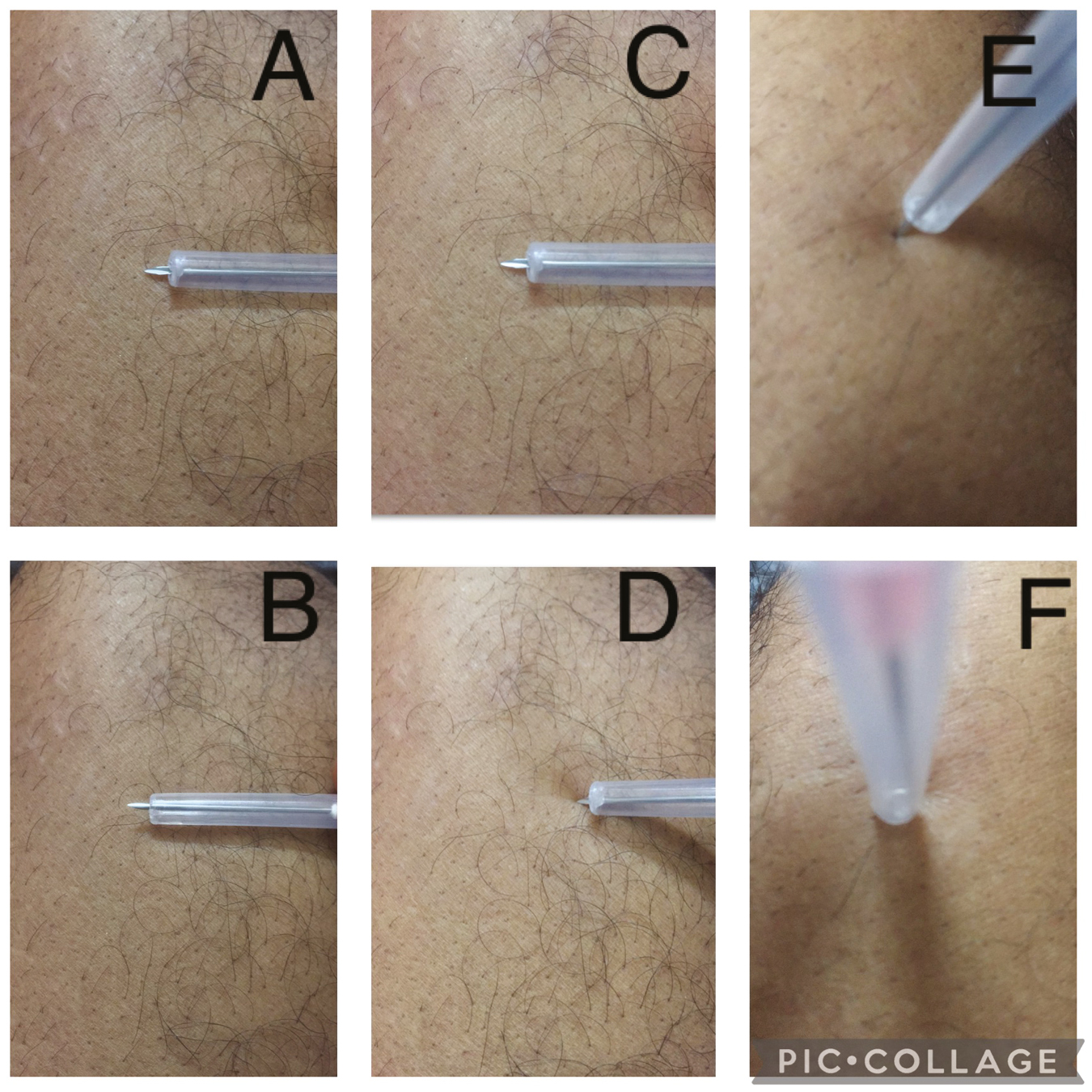Translate this page into:
Surgical pearl: Modified hypodermic needle and its cap for guarded prick incision
Address for correspondence: Dr. Muhammed Mukhtar, Mukhtar Skin Centre, Katihar Medical College Road, Katihar 854105, Bihar, India. E-mail: drmmukhtar20@gmail.com
This article was originally published by Wolters Kluwer - Medknow and was migrated to Scientific Scholar after the change of Publisher.
Abstract
Abstract
There are many instruments to prick the comedone before its extraction and scalp during hair transplantation. These instruments are not well guarded, and it can cause deep injury and fear in the patients. Here we described how to guard these needle for safety during procedure.
Keywords
Acne
closed comedone
disposable needle
extraction
guard
hair follicle
hair transplantation
slit depth
intralesional therapy
keloid
hypertrophic scar
alopecia areata
vitiligo
CHALLENGE
Comedones are common lesions of acne on the face. To extract its content is a good option for reducing inflammation and its side effects. Disposable hypodermic needle,[1-3] aseptic safety pins,[3] are commonly used to prick the closed comedone before its extraction.[1] However, these large needles without a guard may cause fear in patients and, at times, may cause deep pricking injury at the sites. The needle guard is made for extraction of comedone with the use of an aseptic pencil guard.[4] In the same way, “slit making” prior to implantation of the hair follicles (mean length 4.16 mm and its range 3 to 9 mm) is perhaps the most crucial step in the hair restoration surgery. Slit created with hypodermic needle allows the hair follicle to fit snugly into the cavity. However, there is a mismatch in the length of the hair follicle and beveled part of the needle [Figure 1A and B]. For this, a needle guard of micropore tape and of alternate angulation of needle shaft at 90° is a good option for precise incision over the scalp in hair transplantation.[56] Moreover, the procurement of these needle guards is a little cumbersome.

- (A and B) Mismatch in the length of bevel portion (5.5 mm) of 18-G needle and of hair follicle (4 mm)
SOLUTION
Disposable needle (18–26 G) is readily available in clinic. The needle (18–26 G) shaft is cut or trimmed obliquely with a nail cutter (approximately at 1.0–1.5 mm away from its hub to get a pointed and guarded needle. The needle hub acts as a needle guard. Now the cut needle is too small and stocky which is easy to handle like a pen with a syringe. This modified pointed needle is good for extraction procedure of comedone [Figure 2A and B]. With a cut needle 18G (4 mm or more as per the length of hair follicle), after compressing the cut needle shaft with a needle holder, scalp can be pricked or punched [Figure 3A and B]. However, this modified needle is not sharp enough and may cause blunt injury. So it is not as good for split incision over scalp as for pricking of comedone. For guarded and safe slit incision on scalp, the proximal, not distal, part of the needle cap is cut for making needle guard. The cut needle cap is pierced in the rim (not in the center) with the needle being guarded. By guarding the needle with the rim part of the cap, the needle can be used for vertical, horizontal as well as for angled prick and slit incision [Figure 4A–F]. On piercing the cap, the sharpness of needle and fields of vision remain unaffected. Thus these modified needles are well guarded and safe for prick incision for extraction of comedone and hair follicle transplantation. The guarded needle with its cap can be used for intralesional injection vertically in hypertrophic scar, keloids (18–23G) and tangentially in alopecia areata (24–26G).

- (A and B) Modified needle (18 G) with its hub for guarded comedone prick

- (A and B) Modified needle 18 G with its hub (1.5 mm) for guarded slit incision on scalp

- (A-F) 18-G needle is guarded with modified needle cap (4 mm) for horizontal, and angulated and vertical slit incision over scalp for hair transplantation
Financial support and sponsorship
Nil.
Conflict of interest
There are no conflicts of interest.
Declaration of patient consent
The authors certify that they have obtained all appropriate patient consent forms. In the form the patient(s) has/have given his/her/their consent for his/her/their images and other clinical information to be reported in the journal. The patients understand that their names and initials will not be published and due efforts will be made to conceal their identity, but anonymity cannot be guaranteed.
Acknowledgement
I acknowledge to Dr. Vijay Kumar MD, Awish clinic, New Delhi for providing the figure of hair follicles for this article.
REFERENCES
- Surgical pearl: Disposable syringe as comedone extractor. Cosmet Dermatol–Cedar Knolls. 2003;16:57-62.
- [Google Scholar]
- Disposable syringe punching: An aseptic alternative to a comedo extractor. J Am Acad Dermatol. 2020;83:e175-6.
- [Google Scholar]
- Surgical pearl: The safety pin as a better alternative to the versatile paper clip comedo extractor. Int J Dermatol. 2004;43:967-8.
- [Google Scholar]
- Creating slits to the right depth: Innovative use of micropore tape for depth control on an 18-gauge needle in hair restoration surgery. J Am Acad Dermatol. 2021;84:e79-80.
- [Google Scholar]
- A simple method for controlling depth of skin piercing using simple injection needle. J Cosmet Dermatol. 2022;21:337-8.
- [Google Scholar]






